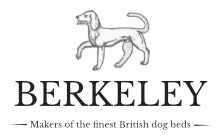Before we start, here are a few thoughts on which to ponder…
The cheapest way to make a dog bed is to cut two pieces of fabric, find some blown fibre or foam and sew it into a bag.
If only it was so simple!
We believe that there really is no viable reason why a dog bed should not last for many, many years.
The best dog beds may cost a bit more than your average bed but spread over the lifetime of your dog they represent excellent value.
1. Cover Material
Dogs like to get wet and muddy and can bring into their sleeping area a whole host of undesirable creatures! It is wise and far more hygienic to invest in a bed with an impermeable waterproof cover to keep the core bed dry and free of damp / mould / mildew and infestations.
Commonly-used cotton fabric used in many dog beds is more suited to clothing or light curtains. Unfortunately, most dogs put their bed through hell so if you opt for a fabric cover, choose a bed with an upholstery grade fabric with a high Martindale ‘Rub Factor’ and, ideally, a short dense pile.
Covers should fit snugly and be removable / replaceable and easy to clean.
At Berkeley, our Waterproof Orthopaedic Dog Bed is fitted as standard with a waterproof removable cover that can be spot cleaned or machine washed and then, if you prefer, you can add an optional softer fabric cover.
Should the worst happen and the cover is damaged, simply replace the cover and not the whole bed.
2. Stitching and Sealing
Regular cotton thread simply doesn’t hold up to the regular punishment your dog is likely to inflict on his / her bed. We use a nylon thread that is virtually unbreakable and then use interlock stitching and / or additional ribbon edging to give optimum strength.
We seal all our covers using heavy duty Velcro. Dogs love zips and although usually cheaper, they tend not to last very long!
3. Filling
If you can press on a dog bed and your hand comes within a few centimetres of the floor it simply will not provide the level of insulation and joint support required. Loosely-packed filling will also quickly become lumpy and fail to provide any form of correct spinal alignment for your dog. Fibre and foam degrade quickly and loose whatever ‘bounce’ they originally had extremely quickly.
Foam fillings in particular can hold damp for a long time and quickly become smelly.
It is also crucial to check that any fire retardant treatments used in foam and memory foam based fillings are certified safe and free from toxic PBDE’s and other harmful chemicals.
Berkeley use natural fillings such as wool felt, lambswool and cotton drill whenever possible.
4. Size
It is always wiser to buy a larger size of bed than you think you may need. Dogs love to move around when they sleep and do not like to be restricted. ‘Doughnut’ or ‘Nest’- shaped beds look snug but would you like to spend all night curled up in one position?
Go large and buy a bed that fits your dog rather than a particularly convenient slot in your room.
5. Weight & Height
Compare weights of the dog beds in which you are interested. Heavier is, as a rule, nearly always better – greater density of filling, superior insulation and less tendency for the bed to move out of position.
As a benchmark, our Large and XL Waterproof Orthopaedic Mattresses weigh over 9 kg and 13 kg respectively.
If you have a larger breed of dog or one that has any form of musculoskeletal condition, getting on to and getting off the bed can be difficult. Both our Raised Dog Beds and Waterproof Orthopedic Mattress are around 20 cm high to make life that little bit easier.
6. Customer Support
It’s always worth asking where a dog bed is made and if replacement covers are readily available. Who can you contact for advice or if the bed develops a fault?
Very few dog bed manufacturers offer any meaningful guarantee – It’s always worth asking why!
So, follow these simple guidelines and you’ll quickly be able to spot top quality dog beds like a true expert!
 Handmade In the UK
Handmade In the UK

